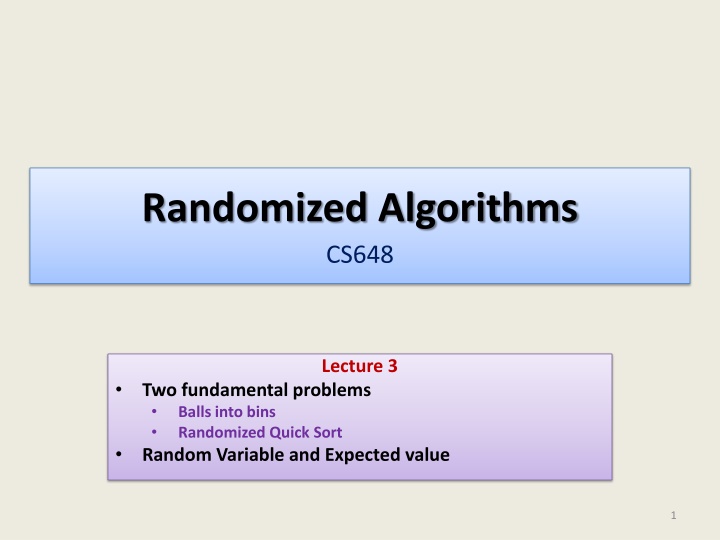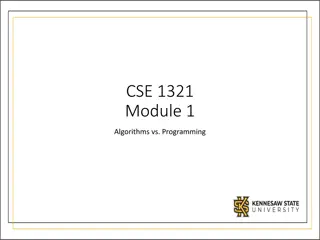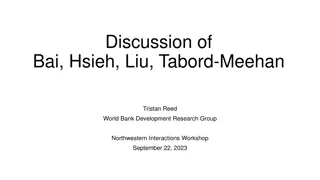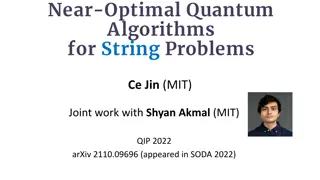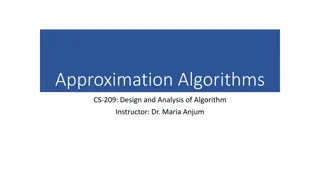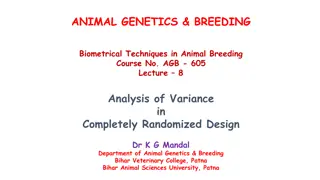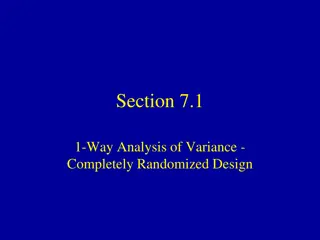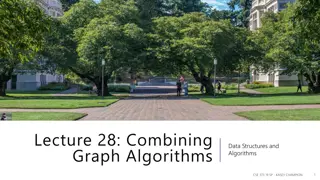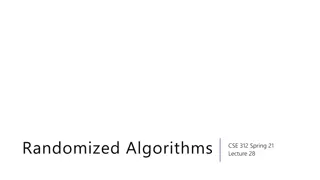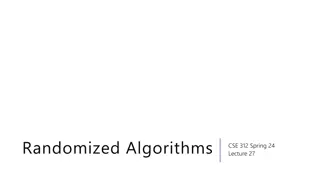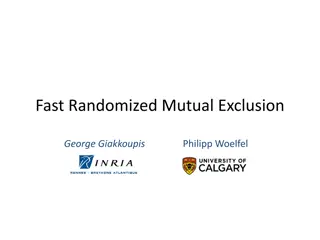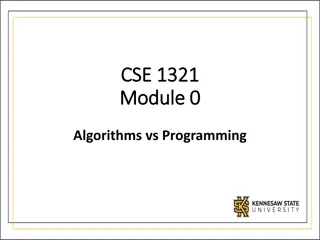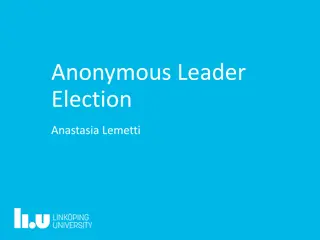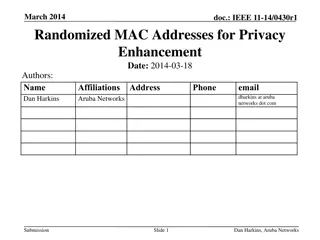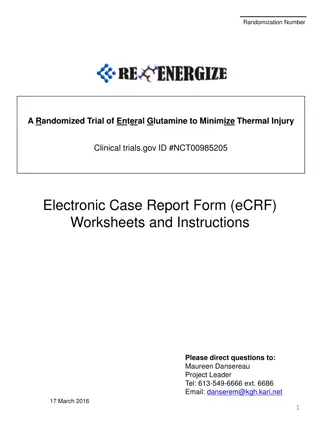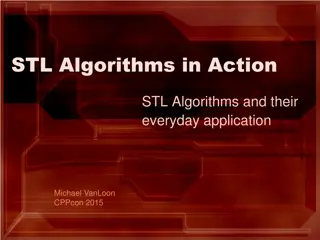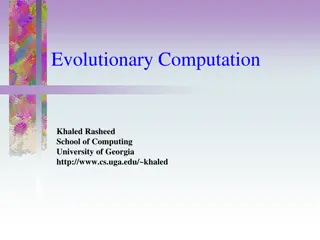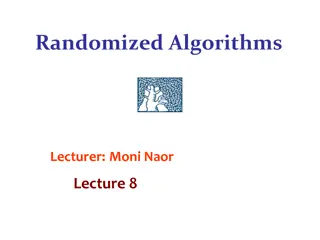Randomized Algorithms
Concept of Balls into Bins in randomized algorithms, focusing on calculating probabilities of specific events and understanding the probability space. Theoretical theorems and experiments are discussed to analyze the occurrence of empty bins.
Download Presentation

Please find below an Image/Link to download the presentation.
The content on the website is provided AS IS for your information and personal use only. It may not be sold, licensed, or shared on other websites without obtaining consent from the author.If you encounter any issues during the download, it is possible that the publisher has removed the file from their server.
You are allowed to download the files provided on this website for personal or commercial use, subject to the condition that they are used lawfully. All files are the property of their respective owners.
The content on the website is provided AS IS for your information and personal use only. It may not be sold, licensed, or shared on other websites without obtaining consent from the author.
E N D
Presentation Transcript
Randomized Algorithms CS648 Lecture 3 Two fundamental problems Balls into bins Randomized Quick Sort Random Variable and Expected value 1
BALLS INTO BINS CALCULATING PROBABILITY OF SOME INTERESTING EVENTS 2
Balls into Bins 1 2 3 4 5 m-1 m 1 2 3 i n Ball-bin Experiment: There are ? balls and ? bins. Each ball selects its bin randomly uniformly and independent of other balls and falls into it. Applications: Hashing Load balancing in distributed environment 3
Balls into Bins 1 2 3 4 5 m-1 m 1 2 3 i n Question : What is the probability that there is at least one empty bin ? 4
Balls into Bins 1 2 3 4 5 m-1 m 1 2 3 i n What is the probability space ( ,P) ? | | = ?? P( ) = 1/ ??for each 5
Balls into Bins 1 2 3 4 5 j m-1 m 1 2 3 i n ??? : ?th ball falls into ?th bin. Events ???and ???are ?? disjoint Events ???and ???are ?? Independent Events ???and ???are ?? Independent 6
Balls into Bins 1 2 3 4 5 j m-1 m 1 2 3 i n ??? : ?th ball enters ?th bin. Pr[???] = ?? 1 ? 1 1 Pr[???] = ?? ? Pr[?1? ?2? ???] = Pr[?1? ] Pr[???] Pr[?th bin is empty] = ?? ?)? =(1 1 7
Balls into Bins 1 2 3 4 5 j m-1 m 1 2 3 i n ?)? Pr[?th bin is empty] = (1 1 (1 2 ?)? Pr[?th and ?th bin are empty] = ?? (1 ? ?)? Pr[a specified set of ? bins are empty] = ?? 8
Balls into Bins Question: What is the probability that there is at least one empty bin ? Attempt 1: Explore the sample space associated with the balls into bins . Express the event as union of some events Attempt 2: ?? Define ??: ?th bin is empty Event there is at least one empty bin = ?=1 ? ?? 9
Balls into Bins Theorem: For events ?1, , ??defined over a probability space (?,P), then P( ?=1 ??) = ?P(??) ?<?P(?? ??) + ?<?<?P(?? ?? ??) ( 1)?+1P(?1 ?2 ??) -------------------------------------------------------------------- = (? 1)(1 1 (? 2)(1 2 +(? 3)(1 3 + 1?+1(? ?)(1 ? ? ?)? ?)? ?)? ?(?,?) ?)? 10
Balls into Bins Homework Exercise: What is the probability that there are exactly? empty bins ? Hint: You will need to use ?(?,?) with suitable values of ?. 11
RANDOMIZED QUICK SORT WHAT IS PROBABILITY OF TWO SPECIFIC ELEMENTS GETTING COMPARED ? 12
Randomized Quick Sort Input: ?[0..n-1] RandomizedQuickSort(?,?, ?) //For the first call,? =0, ?=n-1 { If (? < ?) ? an element selected randomly uniformly from ?[?..?]; ? Partition(?,?,?,x); RandomizedQuickSort(?,?, ? ?); RandomizedQuickSort(?,? + ?, ?) } Assumption : All elements are distinct (if not, break the ties arbitrarily) Notation?? : ?th smallest element of array ?. Question: What is the probability that ??is compared with ??? Recall that the execution of Randomized Quick Sort is totally immune to the permutation of ?. 13
Randomized Quick Sort Question: What is the probability that ??is compared with ??? Attempt 1: Explore the sample space associated with Randomized Quick Sort. Recall that the sample space consists of all recursion trees (rooted binary trees on ? nodes). So count the probability of each recursion tree in which ??is compared with ??. Not a feasible way to calculate the probability View the execution of RandomizedQuickSort from perspective of ?? and ?? Attempt 2: ?? 14
Randomized-Quick-Sort from perspective of ??and?? In order to analyze the Randomized Quick Sort algorithm from the perspective of ?? and ??, we do the following: We visualize elements ?1, ,?? arranged from left to right in increasing order of values. This visualization ensures that the two subarrays which we sort recursively lie to left and right of the pivot element. In this way we can focus on the subarray containing ?? and ??easily. Note that this visualization is just for the sake of analysis. It will be grossly wrong if you interpret it as if we are sorting an already sorted array. Go through the next few slides slowly and patiently, pondering at each step. Never accept anything until and unless you can see the underlying truth yourself. 15
Randomized-Quick-Sort from perspective of ??and?? ?? ?? Elements of A arranged in Increasing order of values 16
Randomized-Quick-Sort from perspective of ??and?? ?? ?? ??? Observation: ??and??get compared during an instance of Randomized Quick Sort iff the first pivot element from ???is either ??or ??. Let us define two events. ?? : first pivot element selected from ???during Randomized Quick Sort is ??. ?? : first pivot element selected from ???during Randomized Quick Sort is ??. Pr[??and??get compared] = ?? Pr[??U??] 17
Randomized-Quick-Sort from perspective of ??and?? ?? ?? ??? Pr[??and??get compared] = Pr[??U??] = Pr[??] + Pr[??] - Pr[?? ??] = Pr[??] + Pr[??] = What relation exists between ?? and ?? ? 1 1 ? ?+1+ = ? ?+1 1 Pr[??] = |???|. 2 ? ?+1 What is Pr[??] ? ?? and ??are disjoint events. 18
Randomized-Quick-Sort from perspective of ??and?? Theorem: During Randomized-Quick-Sort on ? elements, probability ??and??are compared with probability 2 ? ?+1. Inferences: Probability depends upon the rank separation? ? + 1 Probability is independent of the size of the array. ??and ??+1are compared surely for each 0 ? ? 1 . Probability of comparison of ?0and ?? 1is 2 ?. 19
ALTERNATE SOLUTION USING ANALOGY TO ANOTHER RANDOM EXPERIMENT Remember we took a similar approach earlier too: we used a coin toss experiment to analyze failure probability of Rand- Approx-Median algorithm. 20
A Random Experiment: A Story of two friends There were two soldiers A and B serving in the army of a nation named Krakozhia. They were very fast friends as well. During the war, they fought bravely but they got captured by the enemy. A total of n soldiers got captured in this manner. Being war prisoners, their future is quite uncertain. They are blindfolded and placed along a straight line. All the soldiers will be dispatched to different locations in Syberia. A and B are very anxious. They want to meet each other before departing forever. Showing some mercy to the prisoners, the enemy uses the following protocol to break the groups . A person, say p, is selected randomly and uniformly from the current group. He goes and meets every other person in the group and after that the group is broken into two smaller groups: The persons lying to the left of p forms one group and the persons lying to the right of p forms another group. Thereafter, p is sent to some location in Syberia and the two groups are separated from each others and processed in a similar manner recursively. In this manner a group is broken into smaller and smaller subgroups. The order within each group is always maintained. If A and B are located at positions ? and ? respectively initially, what is the probability that they will be able to meet each other ? 21
Viewing the entire experiment from perspective of A and B ? ? 1 2 3 4 n-1 n A B 22
Viewing the entire experiment from perspective of A and B ? ? 1 2 3 4 n-1 n A B 23
Viewing the entire experiment from perspective of A and B ? ? A B 24
Viewing the entire experiment from perspective of A and B ? ? A B 25
Viewing the entire experiment from perspective of A and B ? ? A B 26
Viewing the entire experiment from perspective of A and B ? ? A B 2 Show that the probability A and B meet is exactly equal to ? ?+1. Now try to establish the relation between this problem and the problem we discussed regarding Randomized Quick Sort. 27
PROBABILITY THEORY (RANDOM VARIABLE AND EXPECTED VALUE) 28
Random variable Randomized- Quick-Sort on array of size n Number of HEADS in 5 tosses Sum of numbers in 4 throws Number of comparisons 29
Random variable Definition: A random variable defined over a probability space ( ,P) is a mapping R. Examples: o The number of HEADS when a coin is tossed 5 times. o The sum of numbers seen when a dice is thrown 3 times. o The number of comparisons during Randomized Quick Sort on an array of size n. Notations for random variables : X, Y, U, (capital letters) X( ) denotes the value of X on elementary event . 30
Many Random Variables for the same Probability space Random Experiment: Throwing a dice two times X : the largest number seen Y : sum of the two numbers seen X( ) = 6 Y( ) = 9 31
Expected Value of a random variable (average value) Definition: Expected value of a random variable X defined over a probability space ( ,P) is E[X] = X( ) P( ) X= c X= b X= a E[X] = a Xa P(X = a) 32
Examples Random experiment 1: A fair coin is tossed n times Random Variable X: The number of HEADS E[X] = ?? P(X =?) ? ? ( 12)? ( 12)? ? = ? ? ? = 2 Random Experiment 2: 4 balls into 3 bins Random Variable X: The number of empty bins E[X] = ?? P(X =?) 33
Can we solve these problems ? Random Experiment 1 ? balls into ? bins Random Variable X: The number of empty bins E[X]= ?? Random Experiment 2 Randomized Quick sort on?elements Random Variable X: The number of comparisons E[X]= ?? Spend at least half an hour to solve these two problems using the tools you know. This will help you appreciate the very important concept we shall discuss in the next class. 34
